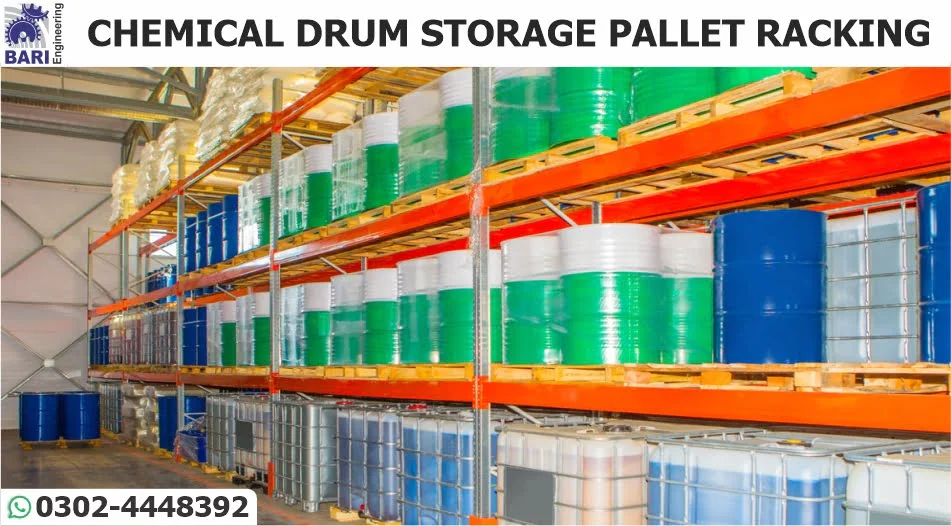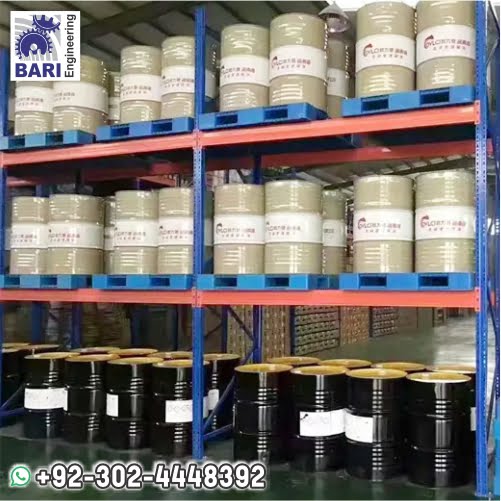Chemical Drum Storage Pallet Rack System:

Chemical Drum Storage Pallet Rack, also known as Chemical Drum Storage Racks, stacks materials horizontally across multiple levels in a designed storage system. storage system designed to stack materials in horizontal rows with multiple levels. With proper Warehouse Racking, warehouse managers maximize space and optimize Warehouse Racking organization for efficiency and a streamlined picking process. Warehouse layout plays a major role in the Warehouse Racking/shelving System, as aisle width, docking locations, shipping areas, and other warehouse components affect warehouse racking/shelving options. Pallet racking is the most common form of Chemical Storage Rack.
Components of Chemical Storage Racks
Load beams, also known as step beams, support materials horizontally in a warehouse rack/shelving system. They fit onto the upright framework, enabling storage.
Upright frames are part of a warehouse racking framework designed to integrate into the warehouse layout.
Weld or bolt diagonal braces between two upright columns to boost rigidity and strength. Horizontal braces or upright frame lacing are alternative names for them.
Enhance safety in Warehouse Racking by using wire decking. This wire mesh fits onto horizontal columns, preventing materials from falling and aiding visibility to identify stored items without accumulating dirt.
Increase column stability with foot plates (face plates) positioned at the base and securely bolted to the concrete floor.
Chemical Storage Racks Advantages
- One big advantage of Warehouse Racking is that it helps to save space. The rack layout maximizes previously unused vertical space for better utilization.
- The warehouse racking system is reliable. It allows you to store your material for a long period.
- It’s much cheaper to employ a racking system than double the square footage of an existing warehouse.
- Adding a racking system can double and sometimes even triple the number of materials you’re able to handle in your warehouse.
- Direct access to each pallet
- Simple stock management
- Adaptable to any product volume, weight, or size
Types of Chemical Storage Racks System
- Selective Racks:
The most commonly used pallet system, selective racks provides access from an aisle. These Warehouse Racking systems are ideal for narrow aisle racking, standard systems, and deep-reach systems. Selective racks require special narrow lift trucks and accommodate a single pallet in depth.
- Drive-In and Drive-Through Racks:
For high-density storage, drive-in and drive-through racks are ideal. Constructed of steel in most cases, these Warehouse rack systems have enough space for a forklift to move into its bay. It’s important to note that drive-in racks have one entrance and exit, but drive-through racks allow access on both sides of the bay. Consequently, the last in, first out (LIFO) process commonly used for nonperishable products or those with a low turnover suits drive-in racks. On the other hand, a drive-through system requires a first in, first out (FIFO) process. Drive-in and drive-through racks may be floor-to-ceiling structures.
- Push Back Racking/shelving Systems:
These systems typically store products in bulk, spanning 2-5 pallets. When loading a pallet onto the system, it pushes the next pallet back; unloading a pallet moves it to the front of the system. Push-back racking systems utilize the LIFO system and often feature inclined rails sliding carts and double lanes.
- Flow Rack:
Flow racks, also called gravity racks, commonly facilitate high-density storage. Users load items at the higher end and retrieve them at the lower end using a FIFO system within this type of warehouse racking/shelving system. The rotation of products becomes automatic as the racks flow with loading and unloading. Flow racks make use of gravity rollers that move in conjunction with the rack load and feature brakes or speed controllers to regulate item movement. One advantage of flow racks is they do not require electricity for operation because gravity powers them.


